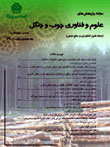Modeling height–diameter relationship for Populus euphratica in Shooshriparian forests, Khoozestan province
Accurate in situ measurement of DBH is easy and cost-effective but, height measurement is labor-intensive, time-consuming and expensive. Understanding its height–diameter relationship is essential for developing growth, biomass production and carbon storage prediction models to be applied in the current forest management projects. The existence of a strong relationship between the diameter and the height of trees is considered as a useful index in forest management and it can be described with mathematical models. Considering that non-linear models are flexible, interpretable and strong, therefore some of the most important models were used in this study.
In this research, 21 widely used candidate nonlinear and one simple linear models were fitted to tree height and diameter at breast height (DBH) data for Populus euphratica Oliv. within a 100 square meter plots at Shoosh area of Khuzestan province. Data from 1163 trees were used and split randomly into two sets: 80 % of the data were used to estimate model parameters (model fitting), and the remaining data (20 %) were reserved for model validation. All model performances were evaluated and compared by means of model performance criteria such as t-statistics of model parameters, root mean square error percentage (RMSE%), mean absolute error percentage (MAE%), mean bias error percentage (ME%), Akaike’s information criterion (AIC) and Bayesian information criterion (BIC).
The parameters of 8 models were not significant at a level of 5%. RMSE, MAE, Bias, AIC and BIC values for M12 model were obtained: 8.98%, 6.78%, -0.0010%, 1451.82 and 1469.73, respectively. The same values were obtained for M21 model: 9.15%, 6.94%, 0.0005%, 1476.95 and 1494.86 respectively. The predicted and actual height values in these two models were not significantly different at a level of 5%. The results of the paired sample t test showed that the nonlinear models M21 and M12 have predicted the height of Populus euophratica trees with appropriate accuracy. Two models (Prodan1 with the name of M12) and (Prodan2 with the name of M21) were selected as the best models based on the ranking of all model performance evaluation criteria in fit and validity data.
The majority of two-parameter models and some three-parameter models showed a significant fit with the data. However, in terms of all performance evaluation criteria, two three-parameter models were chosen as the best models. According to the results of this study and the wide range of non-linear two and three parameter models, mixed models that include one or two covariates in the modeling in addition to the main variables, more research is needed in larger geographical areas, wider sites and stands with different structures are done.


